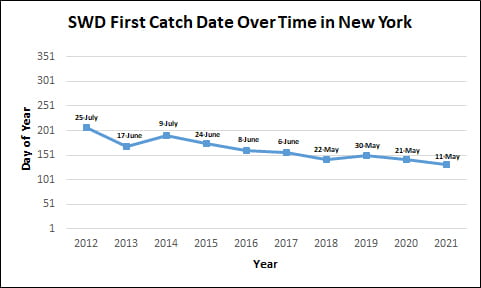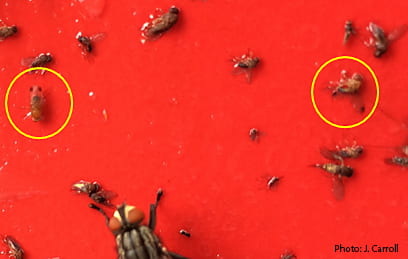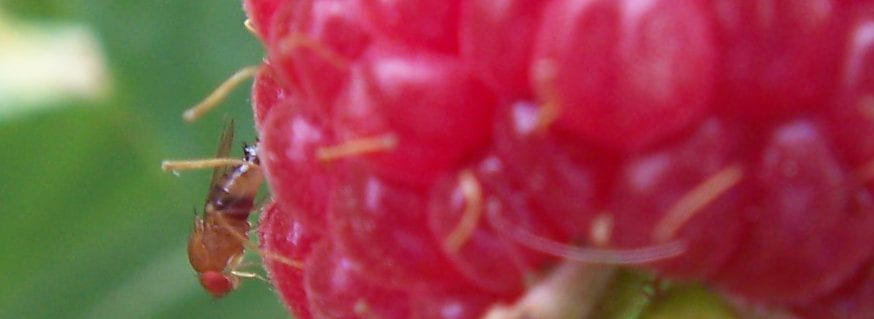Data from 10 years of trapping for first catch of SWD, posted below, shows a trend towards earlier first arrival of SWD into fruit plantings. During the 2021 season, first trap catch occurred over a 14-week-long period, May 11 (Niagara County) to August 17 (Steuben County). This year we tested the utility of red sticky cards, baited with SWD lures. The SWD team achieved another year of successful SWD monitoring! Please join me in thanking the 15 extension scientists who contributed to this effort across 23 counties. Growers in and outside the network locations rely on this information to alert them about the need to protect their at-risk fruits crops from SWD infestation as harvests draw near.
Earlier first trap catch
 From the initial year of trapping for SWD, in 2012, we have seen a trend for first trap catch to be earlier, 76 days earlier. Other northern states with trapping programs have noticed this trend. Could it be SWD is adapting to our climate and more adults are surviving the winters? Could it be related to climate change and milder winters or autumns with fewer early freeze events? Or are the trap lures simply getting better?
From the initial year of trapping for SWD, in 2012, we have seen a trend for first trap catch to be earlier, 76 days earlier. Other northern states with trapping programs have noticed this trend. Could it be SWD is adapting to our climate and more adults are surviving the winters? Could it be related to climate change and milder winters or autumns with fewer early freeze events? Or are the trap lures simply getting better?
Asynchronous first trap catch

Where was SWD during late May and early to mid-June? We don’t know. Most trapping sites weren’t catching SWD during this period, and only one reached sustained catch in early June. “Normally” (is there a normal?) by mid-June, many traps will have caught SWD. Were the lures off? Not the case, we were using both Scentry (in jar traps) and Trece (with sticky cards) lures and these traps, from a quick perusal of my data, yielded comparable results. Perhaps simply another puzzle for researchers to ponder over — weather effects?, natural enemies?, spray programs?
Baited red sticky cards

We achieved success with the red sticky cards, though deployment and use of the cards can be tricky. Stay tuned for more information on this in a future blog. Laura McDermott will be leading a two-year project to work more with these types of SWD traps and educate growers and consultants on their use.
Now, on to thanking everyone!
These 15 Cornell University extension scientists participated in SWD monitoring this year in 23 counties. A special thanks go out to them for setting traps, changing lures, servicing traps, and identifying SWD. This network would not be possible without their support and contributions — suggestions for improvement, ideas for mapping, perspectives on grower needs and steadfast cooperation.
- Andy Galimberti, Eastern NY Commercial Hort Program
- Ariel Kirk, Steuben County CCE
- Barb Neal, Tioga County CCE
- Dave Thorp, Livingston County
- Don Gasiewicz, Wyoming County CCE
- Elisabeth Hodgdon, Eastern NY Commercial Hort Program
- Elizabeth Tee, Lake Ontario Fruit Program
- Faruque Zaman, Suffolk County CCE
- Janet van Zoeren, Lake Ontario Fruit Program
- Jim O'Connell, Ulster County CCE
- Juliet Carroll, NYS IPM Program
- Laura McDermott, Eastern NY Commercial Hort Program
- Liz Alexander, Chemung County CCE
- Natasha Field, Eastern NY Commercial Hort Program
- Sarah Tobin, Eastern NY Commercial Hort Program
Most importantly, we acknowledge the support of our funding partners:
- NYS Berry Growers Association
- NYS IPM Program
- USDA NIFA CPPM EIP Award 2017-70006-27142
Thank you all!
Growers! You know what you need to do to keep your fruit healthy and free of SWD infestation! If you need a refresher, review the information on the Cornell Fruit Resources SWD management web page, fruit.cornell.edu/spottedwing/management/, and learn more about SWD's life cycle on the Cornell Fruit Resources SWD biology and life cycle web page, fruit.cornell.edu/spottedwing/biology-and-life-cycle/ to better understand how infestations, once started, can ramp up.
There are may things you can do in the “off” season to make your fruit plantings less susceptible to SWD. Wishing you successful harvests!

